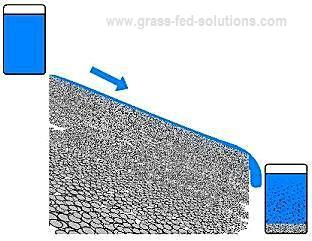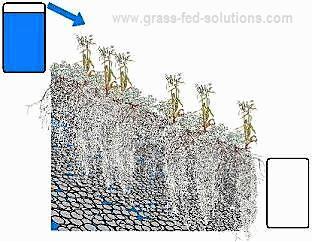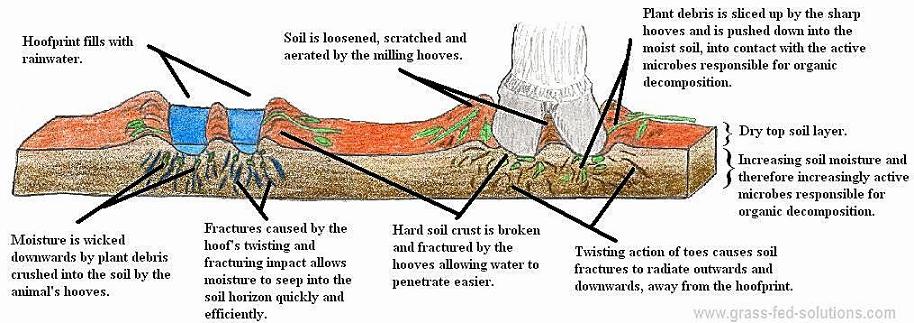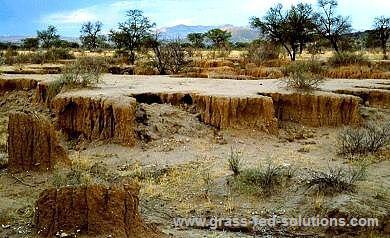Pasture Management with Electric Fences:
Soil Moisture, Drought, Erosion
Part I Part II Part III Part IV
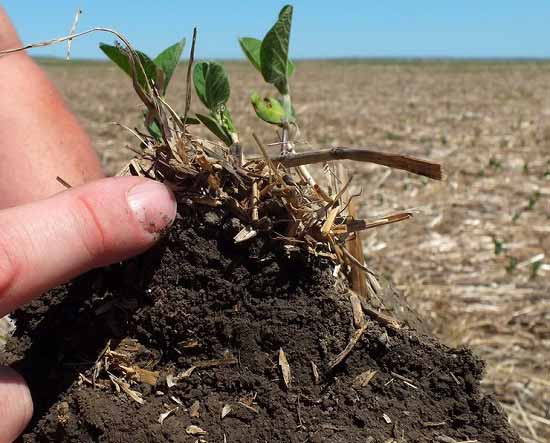
Image Credit: USDA NRCS South Dakota
In Part I and Part II of this Pasture Management with Electric Fences article, I explained how you can use your electric fence grid and your daily pasture rotation to improve your pastures and soils. I also covered the strategies to deal with sensitive or fragile soils, such as along waterlogged riparian areas, flooded pasture areas, or freshly-seeded winter-kill sections of pasture.
On this page, Part III of the article, I will focus on soil moisture. I will explain how to increase your soil's moisture absorption and moisture retention abilities using your daily pasture rotation. I will also explore some of the drought management strategies that will make your pastures more drought-resistance, reduce the severity of droughts, and prepare your pastures for a faster recovery after a drought ends. And finally, I will touch on how to use your pasture rotation to reduce erosion and even repair erosion damage in your pastures.
This whirl-wind tour through this wide range of pasture management strategies is meant to help you build a much more efficient, effective, and flexible electric fence grid that will do more than just keep your cattle in the right pastures. It turns your electric fence grid into your most important farm management tool, simply by harnessing and controlling the grazing behavior of your cattle.
How to use electric fences to increase soil moisture
The water available for plant growth is not just about measuring how much rain or irrigation your pastures receive. It's also about how much water the pasture soils are able to retain versus how much of the water is simply lost to runoff and evaporation. In the "Soil Moisture and Irrigation" chapter of my book, Grass-Fed Cattle: how to produce and market natural beef, I explain that on average 66% of all rainfall or irrigation water is lost to evaporation and another 25% of the water is lost to runoff. That only leaves a pitiful 9% of the total water in the ground where it can be used by plants to support growth!
This frightening statistic is also an enormous opportunity for your rotational grazing program, because if you can simply reduce evaporation losses by a small amount or slightly increase the amount of water that the soil is able to absorb instead of being lost to runoff, you can make very enormous changes to how much water is retained by your pasture soils where it will actually benefit your pasture grass.
For example, imagine you receive 100mm of rain in a month (66mm lost to evaporation, 25mm lost to runoff, and 9mm left over in the soil). If you can reduce evaporation losses by a mere 10% (66m x 10% = 6.6mm) and also reduce runoff by a mere 10% (25mm x 10% = 2.5mm), that would increase the water left over in the soil by a full 9.1mm (6.6mm + 2.5mm). That would more than double your initial 9mm of water that is retained as ground water to supply your pasture grass!
This simplistic calculation is meant to illustrate that the water that falls from the sky is not the same as the amount of water available for plant growth. On the contrary, you have an enormous amount of control over how much water is available for plant growth simply by changing how much water is retained by your soils versus how much water is lost to evaporation and runoff.
And your electric fence grid is your most important pasture management tool to help your pastures hang onto more of that valuable water!
Grass height and shade
Tall growing grass provides a great deal of shade for the soil. This automatically reduces how much the sun is able to beat down on the soil surface and evaporate soil moisture. That's why your pasture management should always leave at least a 6 to 10 inch grass stubble (more is better) in your pastures after grazing to provide shade for the soil.
Tall grass provides more than just shade. It also traps humidity near the soil surface rather than letting it escape into the wind. That humidity prevents further moisture losses, acting as a blanket to hold moisture against the soil. That's why closely cropped pastures are always dry at the soil surface on a sunny day whereas the soil underneath an adjacent pasture that is covered by a nice, thick, tall stand of pasture grass is often moist to the touch and dark and moist in appearance, even after many weeks of hot dry weather.
How much stubble you leave behind after grazing therefore has an enormous impact in how much soil moisture is lost or retained by your pasture soils. Daily pasture slices in your pasture management allows you to control the height of your grass stubble after grazing. You can learn more about how to use your daily pasture rotation to control grass height in the daily pasture rotation article.
Reducing runoff
Water runs downhill, but only if it doesn't get absorbed by the soil first! Again, your pasture rotation provides a very handy tool to reduce runoff. A tall grass stubble or lots of plant growth and debris provides a physical obstacle to slow the water as it runs downhill. The more material that gets in the water's path, the longer it will take to run downhill. The slower it moves, the longer time it has to soak into the soil and be retained for future use. Leaving a tall pasture grass stubble after grazing provides lots of debris to slow runoff and gives the water more time to soak in.
Without vegetation, water will runoff very quickly without giving the soil time to absorb the water. The fast-moving water will also carry off soil particles, which causes erosion.
How much water volume actually soaks into the soil also depends on how easy it is for the water to soak in. A soil that has been lightly chipped and fractured by animal feet and has lots of plant debris littering the soil surface will easily allow water to soak in, whereas a hard, compacted surface will physically prevent runoff from soaking in. The fracturing action of cattle feet in a daily pasture rotation not only loosens the soil surface to prepare it for maximum water absorption, but the plant material pressed into the soil surface by the cattle feet provides a wicking action to draw still more water down into the soil before it is lost as runoff.
Furthermore, dry soil will repel water (that's why water will bead up on a dusty surface, and begin to roll downhill if it's on a slope), whereas moist soil will immediately begin drawing moisture down into the soil. This is a function of the surface tension of the water molecules - water is more strongly attracted to itself than to other materials so it takes time to soak into a dry surface whereas if the soil surface is already moist then the water will begin to soak in right away.
Vegetation slows water runoff, which give the soil time to absorb as much moisture as possible. Slowing runoff reduces erosion and increases soil moisture absorption.
You can see this in action when you water a potted plant - it takes a while for the water to begin to soak in if the soil surface is parched. In the meantime, the water will pool on the surface. Then, eventually, the water will begin to soak in and the pool will suddenly disappear. The more moisture there already is in the soil, the faster the water can be absorbed.
By timing your pasture management to always leave a tall grass stubble, you are ensuring that there is lots of debris to physically slow the runoff. And the shade and the humidity envelope that you create with the tall pasture grass stubble ensures that the pasture soil is as moist as possible so it can absorb as much water as possible when the rains finally come.
Soil Moisture Retention
Not all soils are created equal. Sandy soils allow water to percolate through very quickly so that ground water is quickly lost to the reach of plant roots. Clay or loam soils are able to absorb a huge amount of water, which it can hold onto for a very long time before it sinks below the reach of plant roots. While your electric fence grid cannot swap out the soils themselves, the daily pasture rotation accomplishes two things that increase soil moisture retention:
- In the short term, when your pasture management leaves a tall grass stubble, you maintain a high volume of roots in the soil. The sod mat and root mass can absorb and retain a very large volume of water and thus serves as a wonderful moisture trap for water in the soil.
- Over the long term, when your pasture management consistently uses daily pasture moves, this will increase the dead plant material in the soil (such as roots that die back each time the plant is grazed and surface debris that is pressed into the soil by trampling cattle feet). This organic debris plays a wonderful sponge-like role in the soil, soaking up and retaining water even if the soil itself is sandy and does not hold onto water easily.
Furthermore, over time, soil microbes will break down that plant debris into humus, the rich dark organic matter in the soil, which, like clay, has extremely high moisture absorption and moisture retention properties.
Pasture management to increase soil moisture absorption is all about how you prepare pasture soils using your grazing cattle as a tool. (Click on the image to see a larger version.)
How to use electric fences for erosion control
Increasing soil moisture retention and reducing runoff, discussed in the previous section, will naturally reduce erosion simply by reducing the volume of water rushing down the slopes of your pastures and by reducing the speed of the water rushing across pasture soils.
Soil erosion, like what is shown in this image, is avoidable through good pasture management.Daily pasture moves help to prevent over-grazing, to loosen the soil crust and increase soil moisture absorption when it rains, and to consistently leave a tall grass stubble with lots of plant debris to slow runoff so runoff does not carry off loose soil particles.
However, the added benefit of your electric fence grid and daily pasture rotation is that rotational grazing promotes root and plant growth, which work together to stabilize soils. Pasture soils that are covered by a thick sod mat are nearly impossible to erode unless there is a truly catastrophic flood. Bare soil patches that develop in pastures where the pasture grass becomes uncompetitive through either over-grazing or insufficient grazing are extremely prone to erosion from even the slightest trickle of water than can carry unprotected soil particles downhill.
So, again, your electric fence grid and your daily pasture rotation serve as your primary erosion control mechanisms simply by creating the kind of soil cover and root mass that is highly resistant to soil erosion.
How to use electric fences to reduce the severity of droughts
By the time you've read to this point in this pasture management article you will already know how your daily pasture rotation is able to reduce runoff, reduce evaporation, and increase soil moisture absorption, all of which make your pastures much more drought tolerant.
However, drought management is not just about being more resistant to drought conditions because of your pasture management prior to the beginning of a drought. Drought management is also about what you do in your pastures during the drought to reduce the severity of the drought's impact on your grasses and soils. How you manage your drought-stricken pastures affects how quickly they will recover when the drought ends.
Reducing the severity of the drought
During a drought it becomes even more critical to leave as much plant growth above ground to shade the soil from the beating sun. Just because there's no rain doesn't mean you can throw caution to the wind and graze the last blade of grass into the ground. Your pasture management strategy must do everything possible to preserve as much groundwater as possible in the soil, even if that water is too deep to benefit plants during the drought. The more groundwater you can protect during the drought, the less moisture you will need at the end of the drought to fill up your groundwater table so your roots can reach soil moisture and restart plant growth.
Daily pasture moves are a critical component of your drought management strategy to prevent soil compaction and loosen crusted soil surfaces, which tend to develop under a hot baking sun. This means that when the rains do finally return, your soils will be able to absorb as much soil moisture as possible rather than losing valuable water to runoff as it rushes downhill across parched crusted soil surfaces.
It is extremely important during a drought to leave as tall a grass stubble as possible after grazing. It's better to begin reducing stock early, or tap into hay reserves, rather than using up a grass stubble that is your soil's only remaining protection against the parching and evaporating rays of the sun and wind. During extremely dry weather, even the wind becomes a dangerous drought-enhancing enemy that speeds up how quickly soil moisture will evaporates. Meager plant debris and grass stubble are your soil's only protection to slow air movement across the soil's surface. Allowing your cattle eat your soil's protective shade cover and wind break will only serve to increase the severity of your drought. A few extra days grazing during the drought will only serve to prolong the drought and increase its severity. Drought management means leaving a tall grass stubble to protect your soils!
Speeding up pasture recovery after a drought
The more protective grass stubble you can leave to protect your soils during a drought, the less water it will take at the end of a drought to restart plant growth. Furthermore, by retaining a tall grass stubble you protect your plant roots. Deep roots will draw soil moisture from deeper in the soil and will be able to support faster plant growth when growth resumes. Grazing pasture grass too short during a drought causes the roots to die back to mere centimeters; - remember, what you see above ground approximately reflects the depth of the root mass supporting the plant below ground.
In summary, your pasture management during a drought makes all the difference to how quickly your pastures recover after the drought. Your electric fence grid combined with daily pasture moves provide you with the fine-tuned control over your cattle's grazing impact to prevent overgrazing and to be optimally prepared to weather a drought. If daily pasture moves have also been part of your pasture management strategy even in good times, then you will have reduced the bare patches of soil in your pastures, which are particularly drought-prone, simply by promoting healthy, vigorous, and competitive pasture grass growth.
In Part IV of this pasture management article, I will discuss how to use your electric fence grid and daily pasture rotation to reduce pasture weeds by keeping your pasture grass competitive, grazing weeds when they are most vulnerable, using cattle to physically destroy heavy weed patches to make way for new grass growth, and how to eliminate weed banks on your farm so they don't contaminate your pastures.
Related Articles:
(Disclosure: I get commissions for purchases made using Amazon links in my post.) And when you're ready to start planning your cattle farm, check out my book: Grass-Fed Cattle: How to Produce and Market Natural Beef. Use the links below to explore my book and read reviews on Amazon: 
|

